3 Simple Ways to Make Raising Your Child Bilingually Work
See all articles
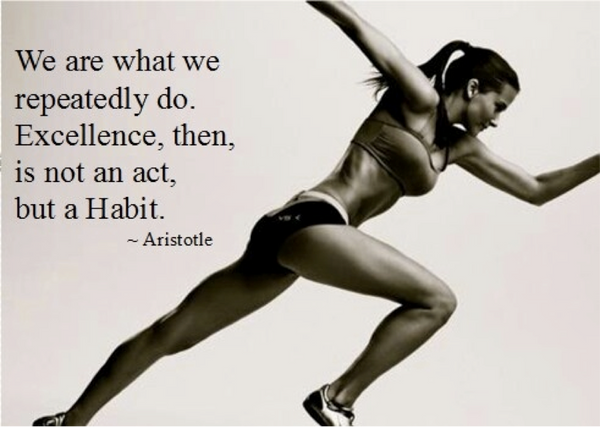
As I exercised this morning -after weeks of doing nothing- it got me thinking: “Exercising is good for me, I know it. I must make the effort to do it every day.”
“3 Simple Ways to Make Raising Your Child Bilingually work”
- Develop a ritual to make starting easier – For us, the best time to do activities is between dinner and bedtime. Having the Kids’ Candor kit in the room makes it easy to grab it, pick an activity and go. The children know is coming and they get excited for the quality time we are about to spend together.
- Start with an activity that is ridiculously small – If my children or I had a long day, keeping it simple is usually the best option. Listening to a song, reading a couple of pages in the book, or only focusing on a few words at a time are activities that require little effort.
- Focus on the habit first and the results after – Nowadays we are very used to instant gratification. It could feel like you are not making any progress after one activity, but similar to a training for a race, it takes time and dedication and you will get the results with time: the rewards are priceless.
If you want to make it happen... make it a HABIT!
Big Bilingual Bonuses
See all articles

A bilingual is not two monolinguals in one body [1]. Within each bilingual, no matter how young, is a brain that is balancing and juggling two languages in one mind. Each time a word is spoken, it has to compete with its other-language equivalent. Whenever a word is heard, it must be correctly catalogued in the bilingual lexicon and matched with its corresponding language. This makes bilingualism one of the most constant brain games anyone can play, strengthening the mind during communication. The advantages reaped via this bilingual mental juggling can have benefits for broader mental function, beginning at early stages in life.
So what are the bilingual advantages for children? When comparing children who have been  exposed to two languages, bilingual children, to their monolingual peers, who have only been exposed to one language, certain trends appear in favor of bilingualism. Bilingual children outscore their monolingual friends in tasks that involve symbolism. They are better at reorganizing information and ignoring misleading information [2]. Because they are constantly, unknowingly choosing between their two languages in all communication, they become good at focusing on what information is important and what information can be ignored. They also tend to develop a stronger metalinguistic awareness than their peers. From having double the language input, bilingual children garner an attention to language structures and elements that monolinguals may not.
exposed to two languages, bilingual children, to their monolingual peers, who have only been exposed to one language, certain trends appear in favor of bilingualism. Bilingual children outscore their monolingual friends in tasks that involve symbolism. They are better at reorganizing information and ignoring misleading information [2]. Because they are constantly, unknowingly choosing between their two languages in all communication, they become good at focusing on what information is important and what information can be ignored. They also tend to develop a stronger metalinguistic awareness than their peers. From having double the language input, bilingual children garner an attention to language structures and elements that monolinguals may not.
Language and cognition researchers use some tasks that mimic games that children already like to play. Remember the game Simon? A series of colors appear or light up and the player is tasked with repeated the colors in the same order. It starts of easy, but gradually gets more difficult as longer color sequences are added. Researchers use a similar task to gauge participants’ working memory, the type of memory that processes new, already-stored information. When five-year-old children play Simon, the bilinguals score better than their monolingual peers [2]. This shows a bilingual advantage in utilizing information stored in working memory.
A prominent keyword now for researchers in the areas of cognition and bilingualism is executive 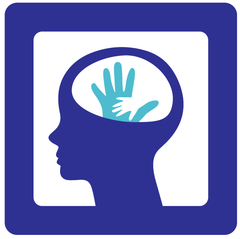 control. Executive control is an umbrella term for a variety of cognitive processes including working memory and problem solving. It is typically developed later in childhood for all children. One research team tested whether bilinguals have added advantage in these areas by using a verbal fluency task [3]. They asked groups of bilinguals and monolinguals at ages four, seven, ten, young adulthood, and older adulthood to name all the words they could think of that begin with a certain letter. This type of task tests word retrieval accuracy and requires executive control. The findings showed that all children improved into young adulthood, but the executive control requirements for bilinguals starting at ten years old were easier than for their monolingual peers. This illustrates that even though children don’t develop executive control functions until later childhood, their prior bilingualism at a young age helps them develop their cognitive skills.
control. Executive control is an umbrella term for a variety of cognitive processes including working memory and problem solving. It is typically developed later in childhood for all children. One research team tested whether bilinguals have added advantage in these areas by using a verbal fluency task [3]. They asked groups of bilinguals and monolinguals at ages four, seven, ten, young adulthood, and older adulthood to name all the words they could think of that begin with a certain letter. This type of task tests word retrieval accuracy and requires executive control. The findings showed that all children improved into young adulthood, but the executive control requirements for bilinguals starting at ten years old were easier than for their monolingual peers. This illustrates that even though children don’t develop executive control functions until later childhood, their prior bilingualism at a young age helps them develop their cognitive skills.
Another advantage gained through early childhood bilingualism is memory flexibility. Brito and colleagues [4] looked at three groups of 18-month-old children, those with monolingual English exposure, bilingual Spanish-Catalan exposure, and bilingual English-Spanish exposure. Spanish and Catalan are closely related languages and Spanish and English are more different. The study found that both groups of bilingual children, regardless of the similarity of the two languages they know, had better memory flexibility than their peers who were exposed to only one language. When the bilingual groups were compared to trilingual 18-month-olds, they found there was no added advantage in memory flexibility to knowing a third language. Importantly, knowing two or more languages allows young children to more easily retrieve the memories they have previously stored, even in new contexts. They can then use this information to generalize what they have learned to new concepts they encounter.
While bilingualism has been and continues to be stigmatized in certain communities, new research into bilingualism and cognitive functions promise a bright future. Bilingual children are able to make cognitive gains from the task of bilingual language processing. As these children juggle two or more languages with every communicative encounter, they are growing their brains in the areas of executive function, like memory, problem solving, and cognitive control. From as early as 18 months, bilingual children’s minds are adapting to their environment by focusing on relevant information and improving learning. Of course there are many cultural, social, and educational benefits to bilingualism, but the research discussed here supports a cognitive bilingual advantage. As a child’s bilingual language skills develop, so does their brain.
To receive updates, news, free music, tools, and much more: sign up for our mailing list, like us on Facebook, subscribe to our YouTube channel, follow us on Instagram, Twitter and Pinterest.
References
[1] Grosjean, F. (1989). Neurolinguists, Beware! The bilingual is not two monolinguals in one person. Brain and language, 36, 3-15.
[2] Bialystok, E., Craik, F.I.M., & Luk, G. (2012). Bilinguals: consequences for mind and brain. Trends in Cognitive Sciences, 16(4), 420-450.
[3] Friesen, D.C., Luo, L., Luk, G., & Bialystok, E. (2015). Proficiency and control in verbal fluency performance across the lifespan for monolinguals and bilinguals. Language, Cognition and Nueroscience, 30(3), 238-250.
[4] Brito, N.H., Sebastián-Gallés, N., & Barr, R. (2015). Differences in language exposure and its effects on memory flexibility in monolingual, bilingual, and trilingual infants. Bilingualism: Language and Cognition, 18(4), 670-682.
Trick-or-Treat: Options for Halloween
See all articles

I just learned that is the official phrase for trick-or-treating in the United States
This is what we use in Puerto Rico, and it is unique to Puerto Rico because no other country uses the term “chavos” to refer to money.
In Colombia, my husband tells me, he used to chant:
I’m sure that other countries have their own versions (please share your favorite Halloween chant in the comments section).
Whoever came up with “Dame chavos no maní” / “Give me money, not peanuts” was ahead of times. Nowadays we are becoming more conscious of allergies and anyone with a child in daycare or school knows that “peanuts” is a big NO-NO. I didn’t think much about allergies before several of my closest friends had to rush to the ER with their babies or toddlers because of food allergies. This Halloween we are joining the Teal Pumpkin Project in support of those who are allergic to foods and still want to enjoy the holiday by giving away non-candy options.
Here is more information on how to manage Halloween, Trick-or-Treating and Food Allergies
Lourdes
Halloween, Trick-or-Treating and Food Allergies
By now just about everywhere we turn there are reminders that Halloween is approaching. There are haunted house advertisements, aisles in grocery stores dedicated to selling bags of candy, yards decorated with cobwebs and ghosts, pumpkins for sale, and photos in your Facebook and Instagram feeds of cute kids in pumpkin patches. I have fond childhood memories of carving pumpkins, creating costumes, loading my pillowcase with treats, and eating frozen candy for weeks. I loved Twix even then. Trick-or-Treat was always the highlight for me even as an adult handing out candy.

Last Halloween we had a newborn and 20 month old. In my postpartum haze, I did not put much thought into celebrating. I had costumes ready and I considered that good planning, although I could not convince our toddler who adores Elmo to dress as him. Seriously, does any toddler like wearing a costume with a hat?
I was exclusively nursing our baby and while we were shopping for trick-or-treat candy, I was so hungry that I grabbed what made me salivate and what I thought was a quasi-healthy option that others would enjoy too. Trying to make a Costco run as time efficient as possible, I grabbed a box of 64 sweet and salty peanut and chocolate granola bars. YUM! Little did I know then that our youngest would be severely allergic to three ingredients and many more foods. And it is likely that one of the little trick-or-treaters who came to our door was allergic to this treat as well. This year we need alternatives to ensure all children can participate.
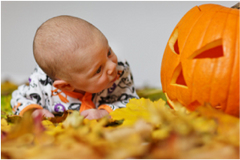
Halloween is a fun and exciting time of year for children and adults. It is a holiday that traditionally focuses around candy and one that is an elevated risk for the 15 million people with food allergies. Food allergies are a growing public health concern. One in 13 children, roughly 6 million, have a food allergy and even a trace amount could cause a life-threatening reaction. While there are over 160 foods that can trigger an allergic reaction, the top 8 allergens (milk, soybeans, peanuts, tree nuts, wheat, egg, shellfish, and fish) are legally required to be listed on foods regulated by the FDA.
For millions of families including us, Halloween needs to be more than conveniently wrapped yummy deliciousness that melts in your mouth. I am not saying anyone should not have these candies; I am simply stating that the cases of food allergies are rapidly increasing and providing fun, safe non-food alternatives allows all trick-or-treaters, including those with diabetes and celiac disease, to participate in this tradition with their friends and family.
One of the ways we will celebrate this year is by participating in the Teal Pumpkin Project by painting a pumpkin teal, the color of food allergy awareness, and hanging English and Spanish signs like these on our door to let trick-or-treaters know that we also have non-food items.

We will not be the house handing out dollar bills, but we will have non-food alternatives. If you are interested in offering a non-candy treat, here is a start:
- glow sticks, necklaces, and bracelets
- sidewalk chalk
- vampire teeth
- spider rings
- sticky or bouncy eyeballs
- stickers
- pencils
- *Play-Doh
- *crayons
* Children very sensitive to gluten and soy may react to touching Play-Doh and Crayola products.
Please note: these items are just suggestions and you should carefully read the labels for age recommendations too. Although this list may not seem as exciting as sinking your teeth into a gooey Twix bar, a child who otherwise has to relinquish this candy to his parents will appreciate having something he can enjoy for at least a few days. And his parents will be happy and grateful for your thoughtfulness too.
If you are unfamiliar with reading an ingredient list, here is an example of what to look for:

This product is very well labeled and goes beyond what is required by the FDA, listing if any of the 8 major allergens in the US are included. Kirkland voluntarily provides additional information stating that this product is made on shared equipment, letting consumers know that it may contain traces of allergens. Many companies do not share this information. Kirkland shows this information in two locations on this product: the ingredient list itself and in a separate allergy section...in the event you missed that chocolate covered almonds contain milk and almonds. :) However, you can be allergic to soy and not to dairy and tree nuts. Good job, Kirkland!
Treats do not have to be food. A treat, as defined by Google, is an event or item that is out of the ordinary and gives great pleasure. I consider it a treat to use the bathroom by myself or to get four consecutive hours of sleep. This Halloween consider having non-food treats. If you would like to show your support by participating in the Teal Pumpkin Project too, click here.
If you are interested in making treats for yourself or for a party that are free of the top 8 allergens, here are some helpful links:
Enjoy Life Halloween Recipes- free of 8 top food allergens
Some Allergy-Friendly Candies from Allergic Living
What are some ways you celebrate that include non-food items and/or foods free of common allergens?
Happy Halloween!
To receive updates, news, free music, tools, and much more: sign up for our mailing list, like us on Facebook, subscribe to our YouTube channel, follow us on Instagram, Twitter and Pinterest.
Halloween and Death: Talking With Your Child
See all articles
“What’s this?” our incredibly curious toddler asked.
“A dead worm,” I responded. Hmm, I do not recall ever using the word “dead” with him. What did he make of it? I couldn’t tell him it was just a worm because he already discovered how live ones move, feel, and taste. Although “dead” didn’t seem to fully register, it continued his exposure to death.
There are going to be many conversations that are uncomfortable and to which I do not have the answers and I may wish I responded differently. I thought about the dead worm off and on for weeks after it happened especially after Halloween paraphernalia infiltrated our grocery stores weeks ago and as neighborhood yards are now decorated with ghosts, graveyards, and mummies.
“What’s this?” This is a zombie.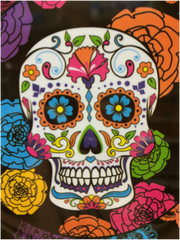
“What’s this?” It’s a tombstone.
“What’s this?” This is a skull.
“What’s this?” This is a plate with a Día de los Muertos design.
And so I began to wonder how do I want our children to understand and celebrate Halloween? They are quite young (2.5 and 1), but I do not think it’s too early to consider and our oldest toddler is beginning to understand.
Ultimately I would like our children to understand there are many ways to celebrate Halloween, or not celebrate it, in addition to Trick-or-Treat night and cute photo opportunites to post to Facebook and Instagram. And here! I couldn’t resist.
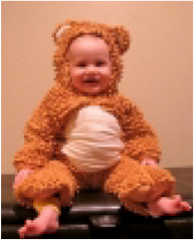

As an elementary school teacher, I taught many students whose families did not participate in Halloween class parties or dress in costumes because of their religious beliefs. Some believed that it  is a pagan holiday associated with witchcraft and satanic worship. Other students, especially in Texas, celebrated Día de los Muertos, a celebration and honoring of deceased family members and friends that continues to November 1st for the Catholic observance of All Saints Day and November 2nd for All Souls Day. Then as a class we also examined how Halloween is celebrated around the world. Teaching children to respect and be sensitive to each individual’s beliefs was a balancing act and multicultural approach. Through these times I deepened my own understanding and appreciation for these differences especially in honoring the lives of loved ones. I want to share this diversity awareness and tolerance with our children as well as a curiosity for learning.
is a pagan holiday associated with witchcraft and satanic worship. Other students, especially in Texas, celebrated Día de los Muertos, a celebration and honoring of deceased family members and friends that continues to November 1st for the Catholic observance of All Saints Day and November 2nd for All Souls Day. Then as a class we also examined how Halloween is celebrated around the world. Teaching children to respect and be sensitive to each individual’s beliefs was a balancing act and multicultural approach. Through these times I deepened my own understanding and appreciation for these differences especially in honoring the lives of loved ones. I want to share this diversity awareness and tolerance with our children as well as a curiosity for learning.
Depending on a child’s age, personality, and life experiences, Halloween may be a natural time to talk about death and loved ones who have passed away. Perhaps as our children are more exposed we will use some observances of Día de los Muertos to honor and celebrate those lives.
Here are a few ways to remember those who have passed away that do not involve ghosts, zombies, or trick-or-treating:
- Share favorite memories with the person.

- Look through pictures of her life.
- Enjoy a food she loved.
- Tell funny stories about her and remember her achievements.
- Visit her grave. Clean and decorate it with orange marigolds, “flor de muerto” or “flower of the dead”.
- Participate in an activity she enjoyed such as playing a special game or volunteering for an organization.
- Include any desired religious or spiritual elements such as prayers and candles.
Death is all around us and kids are more exposed to it than we may realize. It’s in Disney movies. It’s in nature with dead worms and plants. For some children it may be in the death of a beloved pet or family member. It’s a natural part of the plant and animal experience; every living thing eventually dies.
If your child wants to know more about death, here are a few tips on how to navigate those conversations:
- Be open to discussing death when your child is ready. Communication is easier when a child feels safe to talk and ask questions. Watch for his cues of readiness.
- Ask your child to share what he already knows. This can help dispel any misconceptions and provide insight into his fears and worries.
- Listen attentively and respect his views and feelings.
- Be honest and encourage questions.
- Keep your answers short and simple. You do not have to have all the answers but you can create an atmosphere of comfort, understanding, and openness that lets your child know there is not a right or wrong way to feel.
- It is appropriate to express your sadness and grief. This helps children understand that other people have these feelings too and it is an opportunity to demonstrate healthy ways to cope with loss.
- Share any spiritual beliefs as you see fitting.
Q&A Model Responses and Books for Kids About Death
Talking to Children About Death
Helping Children Cope with Death
NAEYC’s Book Recommendations for Children
To receive updates, news, free music, tools, and much more: sign up for our mailing list, like us on Facebook, subscribe to our YouTube channel, follow us on Instagram, Twitter and Pinterest.
Babies and Digital Content? – Think Twice

Parents are often faced with choosing the right content for their children. In their very early years, these choices will prove to be critical for their optimal development. But also very critical is how this content is shared with your baby or toddler - along these lines stands the question: In this day and age, should we leverage digital media technology for teaching our baby/toddler? Is this good for them?
According to the National Association for the Education of Young Children (NAEYC)1, during the earliest years, infants and toddlers interact primarily with people. Their interactions with toys are usually in the context of human interaction as well. They need to freely explore, manipulate, and test everything in the environment. But what about digital content learning?
Here is an interesting story, a few years ago Baby Einstein (owned by Disney) sold DVD’s for young children and suggested this material made the children learn faster. Rebekah Richert2 and her team then published research on Archives of Pediatrics & Adolescent Medicine which showed that the children who watched the DVDs didn't learn any more words than children who did not watch. Further more, past analyses have found that infants who watch educational DVDs learn fewer words and score lower on certain cognitive tests by the time they reach preschool than kids who haven't watched the videos. Baby Einstein then gave a lot of money back3.
What is the moral of the story? There is nothing wrong with technology, but when it comes to very young children, it’s all about the human touch. There is little research to suggest that infants and toddlers learn from watching videos, says the NAEYC1, and if technology is used, it must be in the context of conversation and interactions with an adult. Here are some take-aways, when it comes to teaching your baby/toddler:
- Babies are better able to learn sounds if they hear them from a live speaker (a parent) who engages with them directly and uses language in a repetitive, reinforcing way2.
- Allow children to explore any digital materials only in the context of human interactions, with an adult as mediator and co-player1.
- Children of this age are drawn to push-button switches and controls. Technology tools that infants and toddlers might use must be safe, sturdy, and not easily damaged1.
- Use shared technology time as an opportunity to talk with children, use new vocabulary, and model appropriate use. Avoid passive screen time1.
- Most importantly, remember the guideline from the American Academy of Pediatrics: Television and other entertainment media should be avoided for infants and children under age 2. A child's brain develops rapidly during these first years, and young children learn best by interacting with people, not screens4.
To receive updates, news, free music, tools, and much more: sign up for our mailing list, like us on Facebook, subscribe to our YouTube channel, follow us onInstagram, Twitter and Pinterest.
References:
- The National Association for the Education of Young Children (NAEYC) Effective Classroom Practice: Infants and Toddlers http://www.naeyc.org/content/technology-and-young-children/infants-and-toddlers
- Time.com - Baby Wordsworth Babies: Not Exactly Wordy. By Alice Park Tuesday, Mar. 02, 2010 - http://content.time.com/time/health/article/0,8599,1968874,00.html
- The Guardian.com, Disney offers Baby Einstein refunds by Katie Allen - http://www.theguardian.com/media/2009/oct/26/disney-offers-baby-einstein-refunds
- The American Academy of Pediatrics - Media and Children - https://www.aap.org/en-us/advocacy-and-policy/aap-health-initiatives/pages/media-and-children.aspx
Developing noun phrases in Spanish and English
See all articles
“Dada!” “Mama!” “¡Papá!” “¡Mamá!”
A child’s first word is a momentous occasion. As it should be! Today, we scramble for cell phones, share videos with relatives around the world, and wait to find out what word number two will be. It is an exciting time in the child and parents’ lives. As the months stretch on, the child learns more words and her vocabulary grows. Now she can say:
“Dada!” “milk” “want” “no” “ball”
Individually, the child can communicate a variety of meanings with just five words. If she says “want” when there is a piece of fruit on the table, her parents know that she would like to eat the fruit. “No” by itself can turn down and number of activities suggested by a parent and “ball” can signal playtime. Once she has enough words in her repertoire, the trick is compiling them together in meaningful and well-structured phrases.
When she says “milk” by itself, she could be thirsty or she could be pointing out a familiar object. If she says “want milk” it becomes clear that the interpretation should be the former; she would like to drink the milk. Although few adults would agree that “want milk” is an acceptable English sentence. (Imagine using it to order a latte at a café!) Yet for children, it’s the way they explore creating phrases for the first time and it’s perfectly normal. It’s an exciting step in language development.
Looking from afar, the formula for building sentences is simple. Take some words that have the meaning you want, add them together in a way that is permissible in your language, and there you go! When we look closer, it gets a bit more complicated for these young language learners. They have to take the meaningful words like “want” and “milk” and tie them together with function words like “I” and “the”. Together “I want the milk” becomes a well-formed, English sentence.

One way linguists gauge a child’s progress in language development is by measuring the Mean Length of Utterance (MLU). This is done by counting the meaning-bearing parts of each phrase or utterance. For example, “ball” would have an MLU of one, “want ball” would have an MLU of two, and “want balls” would have an MLU of 3 because “ball” carries the meaning of the round toy and the plural marker “-s” signifies that there are more than one. Overtime, MLUs grow in length as children’s vocabulary and language structure skills grow. Children don’t start off spitting out full, complex sentences, but they build them up slowly over time (adding about 1.25 units per year) and different children increase their MLUs at different rates [3]. So parents, have patience and keep talking to your child. Don’t be alarmed if siblings develop utterances in different ways.
Looking at noun phrases in English and Spanish, we can see that they differ quite a bit and children need to have acquired some function words, like “the” or el/la to produce adult-like noun phrases. In English, we put the definite article “the” first followed by the adjective (if there is one) and then the noun, e.g. “the red ball”. In Spanish, we also start with the article, followed by the noun, and the adjective often comes last, e.g. la pelota roja. Additionally, in Spanish, we have the added feature of grammatical gender. All Spanish nouns are either assigned feminine or masculine gender and the article and coordinating adjectives must agree with the gender marked on that noun. To say the “the red ball” in Spanish, “ball” pelota has feminine gender so the article must be la and the adjective must end in –a, roja “red”.

In both Spanish and English, plurals (most often) are formed by adding –s to the ends of nouns. We can have one “ball” and pelota or two “balls” and pelotas. In English, this has no bearing on the article or the adjective. “the” and “red” do not change whether we use the singular “ball” or the plural “balls”, but in Spanish, the article and adjective must agree with the noun to form la pelota roja “the red ball” and las pelotas rojas “the red balls”. While it may seem as though grammatical gender and plurality complicate noun phrases in Spanish, native speakers are very good at acquiring these patterns and using them to produce well-formed noun phrases.

In the beginning, children may not be producing noun phrases, preferring to use bare nouns like “ball” instead of “the ball”, but they are listening when parents produce these sentences and are slowly learning to incorporate them in their own speech. When listening to Spanish they can pay attention to the sound endings, the feminine –a at the end of pelota compared to the masculine –o at the end of queso “cheese”, the distribution of these sounds in the speech stream, and the way they function in sentences. These three aspects will help them learn and use grammatical gender in their speech later on [1].
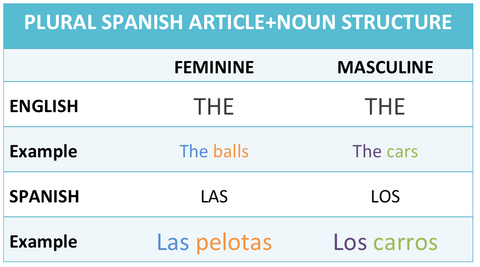
As they are developing their understanding of ways to make good noun phrases, children may use article-like elements that are marked for proper grammatical gender when they are in the two word stage. Instead of using la with feminine words like la pelota or el with masculine words as in el queso, the child might say a pelota or e queso. This shows the beginnings of grammatical gender development in Spanish speakers and bilingual children. Additionally, if they use an adjective, they may make it agree with the noun in gender even if there is no article present, such as in the feminine phrase mamá linda “pretty mama” [2]. These types of categories that play a more functional role in language, such as plural and grammatical gender markers, may be appear at different times in the language learning process for different languages. What is important, as always, is for parents to give their children plenty of good input and overtime, the children will be able to use these elements of speech effectively.
FREE TRIAL ON NEW SUBSCRIPTIONS
Offer valid until October 15, 2015
To receive updates, news, free music, tools, and much more: sign up for our mailing list, like us on Facebook, subscribe to our YouTube channel, follow us on Instagram, Twitter and Pinterest.
References
[1] Mariscal, S. (2008). Early acquisition of gender agreement in the Spanish noun phrase: starting small. Journal of Child Language, 35, 1-29.
[2] Montrul, S. (2004). The Acquisition of Spanish. Morphosyntactic Development in Monolingual and Bilingual L1 Acquisition and in Adult L2 Acquisition. [Series on Language Acquisition and Language Disorders]. Amsterdam: John Benjamins.
[3] O’Grady, W. (2005). How Children Learn Language. [Cambridge Approaches to Linguistics]. Cambridge: Cambridge University Press.
Bienvenidos. We are OPEN!
See all articles
 Today, Sept 15 is the beginning of the Hispanic heritage month. It's also the official beginning and opening of Kids' Candor.
Today, Sept 15 is the beginning of the Hispanic heritage month. It's also the official beginning and opening of Kids' Candor.
Our own children inspired Kids’ Candor. They are growing fast, and every moment with them is precious. I see their reality is different than mine when I was their age. They are growing up in a multilingual and multicultural world. Consequently, my husband and I would like them to be raised with an unquenchable thirst and curiosity for learning about the world, other cultures and other languages. Determined to provide the best for them, and after being underwhelmed with the educational tools current offered in the market, we started to make our own materials. We soon realized that we were not the only ones searching for the same solution.

Today we are making our materials available to the public: a bilingual, English/Spanish, solution that includes original music, guided activities and materials, books and toys. We are excited and proud to share with everyone what we believe will make a positive difference in the lives of young children and their families. For the next month, we are offering a risk free trial of any subscription. Educational Kits Subscriptions.
As I mentioned before, today marks the beginning. As we state in our vision, we strive to be the catalyst for parents and caregivers to raise children bilingually since birth. We hope you join us in our journey.
Gracias,
Lourdes Ramón
Press Release: Bilingual Kits for Children Delivered to Your Door
White Plains, NY, September 15, 2015 - Kids’ Candor a US provider of bilingual tools for early childhood development, announced it is opening its website for business to the general public on September 15. Based on a subscription model, the venture was founded on March 2015 and completed a beta test on May this year which enjoyed an overwhelmingly positive response by users, according to its creators.
Kids’ Candor bilingual curriculum includes games, original music, educational activity materials, toys, books and guide cards in monthly kits. With 5 different stages to choose from, each kit is crafted for the child’s age, starting at birth until preschool. Music, flashcards and other materials will be also available for stand alone purchases.
“Our native language is Spanish and we want to raise our children bilingual,” says co-founder and President Lourdes Ramón. “We were not pleased with the current offers in the market and we started to make our own materials”, explains Lourdes on how the idea was born.
Quality and original content is a differentiator for the company, which has set out to complete production and publishing of 192 original children songs in a period of 12 months, and plans to add their own children’s books to their kits as soon as Spring of 2016.
About Kids’ Candor
Kids Candor, Inc. is a company focused on bilingual early child development. Inspired by their need to raise their children bilingually and fueled by the drive to provide the best for them, Lourdes Ramón and her husband Jorge Gallego founded Kids’ Candor in 2015. Kids’ Candor provides bilingual solutions for early childhood development through play, music, and guided human interaction. Learn more about Kids’ Candor at www.KidsCandor.com or contact Lourdes Ramón at 347-257-2050 or email, lourdes.ramon@kidscandor.com
Mixing It Up with Multiples
See all articles
September 6th was National Read a Book Day! Seriously. There must be something for every day. The fact that there is a day dedicated to reading books is exciting, although let’s not limit it to just one! I was not only excited for National Read a Book Day simply because I'm a teacher and I love to read but also because reading is a simple activity that I can do simultaneously with our children and they enjoy it.
I don't want to mislead you; there are challenges with this simple activity. Our boys are 2.5 years old and eleven months (nineteen months apart, and yes that was planned). There are occasional battles over who gets to hold the book, turn the pages, or, with our youngest, attempt to eat the book. But, for the most part, they love this time of listening to me read and I can easily find ways to include both of them.

While I may be relatively new to raising two children and finding activities that incorporate both of them while still meeting their individual needs, I leverage my experiences as an elementary teacher and a nanny to 0-4 year olds. Working with groups of children, or even just two children, whose skills and abilities differ is beautiful. Sometimes it's a beautiful mess, and that's okay. Mixed-age activities provide children opportunities to develop and practice important social skills such as sharing, being gentle, being patient, sharing, having compassion, being gentle, showing empathy, sharing, solving problems, SHARING, and BEING GENTLE! Geez, the emphasis is for our toddler and his big brother hazing techniques.
Here are the boys exploring their first Kids’ Candor Educational Modules and practicing how to share:

There are numerous benefits that we as parents and caregivers will witness including, but obviously not limited to, cute photo opportunities and harmony. Then there are benefits we will not witness immediately. Or even within weeks. Or months or years and, for little ones, it's developmentally appropriate. Older children, siblings or not, will become the teachers and leaders. My 5th grade students matured as role models and transformed into super stars for their kindergarten book buddies, which was another fun way to encourage reading. With the older children I care for as a nanny, I have observed their care taking and helpful behaviors when they are near our youngest son. They role play changing a diaper and dressing and burping a doll. If our baby wasn't an escape artist, perhaps I would let one change him! Sometimes "teacher" and "leader" can be interpreted as "boss", and distinguishing those terms is another lesson. Furthermore, I have also noticed that older children seem to circle back to toys meant for younger children and they find more creative ways to use them.
Here our oldest son thought it was hilarious to make a pig-sheep and to play with his younger brother’s puzzle:
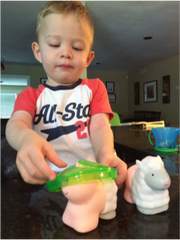

The younger children gain from these experiences as well; they are challenged by the older children and they want to emulate them. They want to play with the big kids and copy what seems like everything. They are exposed to more language and they want to engage in more complex and physical activities.
Engaging in activities with mixed ages and abilities has its challenges. I include abilities because we know that every child is unique and does not develop in a cookie-cutter fashion. Safety is first especially with toddlers and infants. There are chairs and shelves to climb, cabinets and doors to open, and, sometimes, utensils on the counter. Then there are otherwise non-hazardous items that can easily fit into a child's mouth such as tiny Legos, crumbs on the floor, craft scissors, crayons, Play Doh, and paper. Paper! Beyond safety there are challenges in planning and managing activities for various interests, ability levels, and skills. Not everyone can play Elsa and sing Frozen songs all day or talk like Elmo for more than 10 minutes. Some of us need a break. And the kids need variety too! Then, even with careful planning, normal daily routines such as naps, diapers, potty training, and snacks may start and end at different times. Although the challenges can be exhausting at times, it is possible and there are ways to make it easier and more enjoyable for everyone.

Here are a few tips for working with children of various ages and abilities, whether the children are siblings, friends, or strangers:
- Safety is first. The kids will be happy and secure, and it will also help keep your sanity.
- Offer a wide selection of safe toys, books, and materials.
- Provide age-specific activities in a safe location or at a safe time. Consider making crafts for older children at a raised table or during a toddler's nap.
- Use versatile toys and materials that are open ended.
- Incorporate books and songs that can be used for a variety of ages especially if there is a large age gap; tailor your questions and comments accordingly.
- Spend time focusing on an activity with each child. They love your attention!
- Use this time to practice and celebrate cooperation and teamwork.
- Be flexible.
- Have fun!
When I was 38 weeks pregnant and our oldest was 18 months, a mother of four kids who are five years old and younger gave me beautiful advice. She told me that no matter how chaotic times become to try my best to not let them see me stressed. I have found this to be helpful with our children and others. Kids feed off the energy we bring, and it's much easier to engage children when we are having fun.
Do you see why reading works so well? I love it. Other activities that have worked for us include building with red bricks, blocks, and Duplos; stacking and sorting anything; dancing and singing; using rhythm instruments; doing anything with balls; creating stories with props like stuffed animals, scarves, and blankets; going on a nature walk; playing with water and containers; driving cars, trucks, and trains; hiding in boxes (and cabinets); and, when I'm feeling brave and can keep a close eye on our youngest, coloring and painting.

What activities do you like to do with children of mixed ages and abilities? I would love to hear your ideas!
Remember, we can celebrate National Read a Book Day every day!
Pre-Order your Kids’ Candor Subscription Now!
Use code: KCFAN for 20% off
To receive updates, news, free music, tools, and much more: sign up for our mailing list, like us on Facebook, subscribe to ourYouTube channel, follow us on Instagram, Twitter and Pinterest.
Infants build a complex sound system
As you read this post, read it aloud. Create a speech signal. Take in the sentences; listen to the words. Now, distinguish the individual sounds. As a literate adult, you are a practiced and experienced language processor. But how did you get that way? Where did it begin? Before you understood the concept of language, your brain was taking in the vast input in your environment and beginning to develop a sound system unique to you and your language(s). Before their first words are uttered, infants make impressive strides in developing sound systems.

The speech signal is not made up of perfectly spliced words and sounds. It is a fluid act of articulation. Infants absorb this information and use it to perceive speech around them. Bilingual infants have to listen the sounds of both of their languages and distinguish them from each other. For example, the placement of the tongue when making a /d/ sound in English is different than that of French. Bilingual infants need to be able to tell 1) that there is a difference between those two sounds and 2) correlate them with the correct language. Early in life, infants are equally successful at discriminating all sounds. However, by the end of the first year, infants tune their ears to their own language(s) and lose their ability to distinguish nonnative phones. In the case of /d/, at 6-8 months, all infants could distinguish between English-like and French-like /d/ sounds, but by 10-12 months, bilingual infants retained this ability and French monolingual infants were no longer able to tell the difference between the two types of /d/[4].
This process shows how efficient the mind is. Monolingual infants do not need to retain sounds used in other language to be successful communicators. However, it is important that bilingual infants are exposed to both languages from an early age. One study suggests that those infants who are more successful at discriminating sounds in their native language at 7 months have accelerated language learning abilities at 24 and 30 months[3]. Yet, parents need not fret! The process of understanding sounds begins in utero. By counting the number of times infants only 33 hours old sucked on a pacifier, it was shown that they are already sensitive to familiar and unfamiliar sounds[2]. While it is important to communicate often and well to your children once they are born, the ambient noise they are exposed to in the womb can help structure their phonetic systems.
It may seem as though bilingual infants are presented with a trickier task than their monolingual counterparts, but in reality, they are able to distinguish their two languages from the start. Though there is evidence that two languages influence each other, bilingual infants can recognize familiar sounds from unfamiliar sounds. Additionally, they can also distinguish between their two languages and a third, unfamiliar language[5]. When creating sound systems, bilingual infants are on pace with monolingual infants, despite their need to make two distinct systems.
Speaking and interacting directly with infants can support their sound system development as well. Languages have different rules for how sounds can work together to create words. This is vital for a strong vocabulary. By looking at English and Japanese, two languages with different distributions of sounds, infants are able to use the cues provided by their mothers to better perceive the speech signal[6]. Not only do infants listen to the sounds in their environment, they catalogue their occurrences[1]. For example, by observing the distribution of the word “happy” with other sounds in the speech signal like “happy mommy,” “happy baby,” and “happy kitty”, the infants will begin to understand which sounds pair together to form words. They learn that “ha-“ and “-ppy” go together often and “-ppy” and “mo-“ rarely go together. While word learning and word saying come later in infant language acquisition, it’s important that they have the solid structure of sound system(s) to build upon.
Infants learn quickly and begin to explore their worlds even before they are born. Both monolingual and bilingual children are efficient at analyzing their environment and focusing on the languages of their families and communities. This means that ample exposure to sounds and infant-directed communication are crucial to development. While it may appear that bilingual infants have to work doubly hard, they are expert language learners and can connect the sounds they hear to the languages to which they belong. In turn, they are able to use the sound systems they build to master their languages as they grow.
Pre-Order your Kids’ Candor Subscription Now!
To receive updates, news, free music, tools, and much more: sign up for our mailing list, like us on Facebook, subscribe to our YouTube channel, follow us on Instagram, Twitter and Pinterest.
References
[1] Maye, J., Werker, J.F., & Gerken, L. (2002). Infant sensitivity to distributional information can affect phonetic discrimination. Cognition, 82, B101-B111.
[2] Moon, C., Lagercrantz, H., & Kuhl, P.K. (2013). Language experienced in utero affects vowel perception after birth: a two-country study. Acta paediatrica (Oslo, Norway : 1992), 102(2), 156-160.
[3] Kuhl, P.K., Conboy, B.T., Padden, D., Nelson, T., & Pruitt, J. (2005). Early Speech Perception and Later Language Development: Implications for the “Critical Period”. Language Learning and Development, 3&4, 237-264.
[4] Sundara, M., Polka, L., & Molnar. (2008). Development of coronal stop perception: Bilingual infants keep pace with their monolingual peers. Cognition, 108, 232-242.
[5] Werker, J.F., & Byers-Heinlein, K. (2008). Bilingualism in infancy: first steps in perception and comprehension. Trends in Cognitive Sciences, 12, 144-151.
[6] Werker, J.F., Pons, F., Dietrich, C., Kajikawa, S., Fais, L., & Amano, S. (2007). Infant-directed speech supports phonetic category learning in English and Japanese. Cognition, 103, 147-162.
6 Things that Make a Good Children's Song
See all articles
Follow this rule: If you think it’s bad, it probably is…
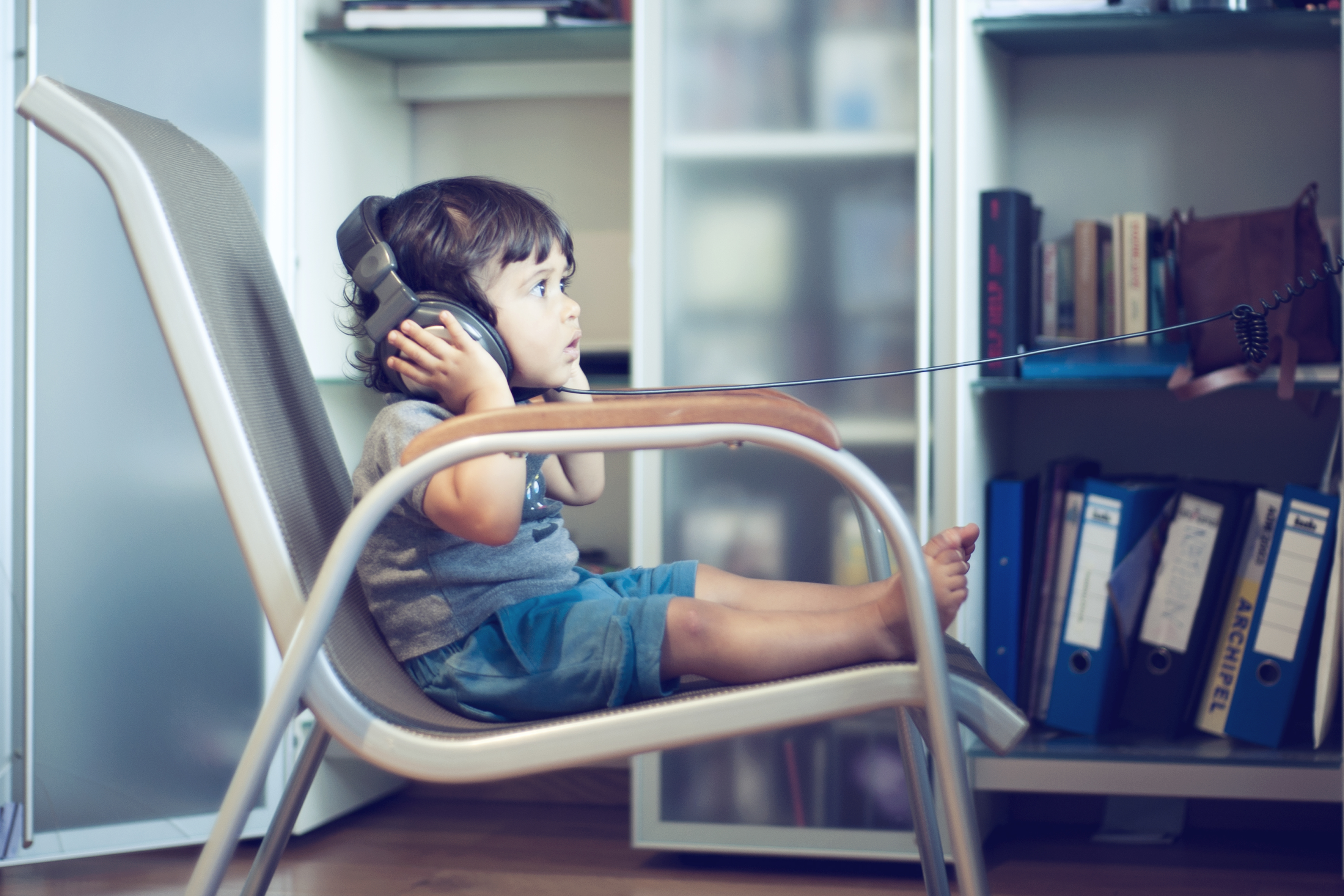
Photo by Philippe Put
Most parents of pre-school children would agree there is surprisingly little information or guidance on the internet as to what constitutes a quality children's song. Perhaps most important for parents, is which music should one be playing to small children and why.
A quick search on the internet would reveal a large number of children music creators, and a quick listen would reveal several common denominators. For starters, a lot of content are new renditions and tweaks of already existing, well known children's songs. One will also notice the lyrics and music tend to be extremely simple, and the simple explanation is they are "for children" - but is that really what children need or want? Or is it rather a reflection of what we believe they can understand?
For good or worse, young children are no sophisticated judges of musical craftsmanship, although to some parents it is apparent that there are some songs their young ones favor over others (hint: "let it gooooo"...).Not unlike the rest of us, children succumb to catchy "hooks". A great deal of musicians would agree that a good hook is an element of a good song, and one that would capture a greater audience. From a parent's perspective, catchy songs would be a complete win-win (children- parents) if the songs went beyond entertainment and actually contributed to their children development.
That music is beneficial to your child remains a fact. According to Diane Bales, Associate Professor at University of Georgia, listening to any kind of music helps build music-related pathways in the brain, plus music can have positive effects on children's moods that may make learning easier(1). But, what music should they listen too? Here is a summarized list of tips from reliable sources:
- Expose your child to many different musical selections of various styles (1), and remember to actively listen to music. While having music playing in the background is extremely helpful, it is also important for your child to attend to and interact with music regularly (2).
- Use upbeat popular music to motivate learning, especially songs with lyrics that encourage positive thinking (4).
- When picking songs, remember that to get the full benefits of music, children need to sing, clap and dance along with the tunes. Singing and moving to music tells the brain to make meaning of it, a cognitive process called audiation (5).
- Favor the complexity and tonal quality of classical music. Babies as young as 3 months can pick out the structure of classical music and even recognize classical music selections they have heard before. Researchers think the complexity of classical music is what primes the brain to solve spatial problems more quickly. (1)
- Kids’ music that is geared toward children is not necessarily very healthy music for children to be listening to. Follow this rule: If you think it’s bad, it probably is. (5)
- "Lastly, remember that music is one of life’s most meaningful experiences. It is a uniquely human experience, and as such it should never be forced on a child. Instead, make music a part of everyday life that improves everything we do. If you instill this value in your child at a young age, they will be grateful when they’re older as they continue to explore a relationship with music."(2)
Kids' Candor's library of original bilingual songs addresses important needs in this space by 1) challenging children's intellect with its educative content and bilingualism and 2) providing quality music that is both diverse and catchy for both kids and grown-ups. And there is a plus: according to James Adler (3), an active composer and performer of children music in New York City, "Most Kid's Candor's songs reflect the musical nuance quality also found in classical compositions".
--------------------------------------------------------------
To receive updates, news, free music, tools and much more: sign up for our mailing list, like us on Facebook, subscribe to our YouTube channel, follow us on Instagram, Twitter and Pinterest.
(1) Bales, D. (1998). Building Baby's Brain: The Role of Music. Athens, GA: University of Georgia, College of Family and Consumer Sciences.
(2) Creating a Musical Home Environment by Dr. Robert A. Cutietta,Dean of the University of Southern California Thornton School of Music.
(3) James Adler, classically trained children music composer and performer. Lives in New York City and is the creator of The Munchkin Music Club. http://themunchkinmusicclub.com/.
(4) Boost Memory and Learning with Music by Cheri Lucas, Education.com
(5) What Music Should My Child Listen To? By Laura Lewis Brown, PB


 Today, Sept 15 is the beginning of the Hispanic heritage month. It's also the official beginning and opening of Kids' Candor.
Today, Sept 15 is the beginning of the Hispanic heritage month. It's also the official beginning and opening of Kids' Candor.